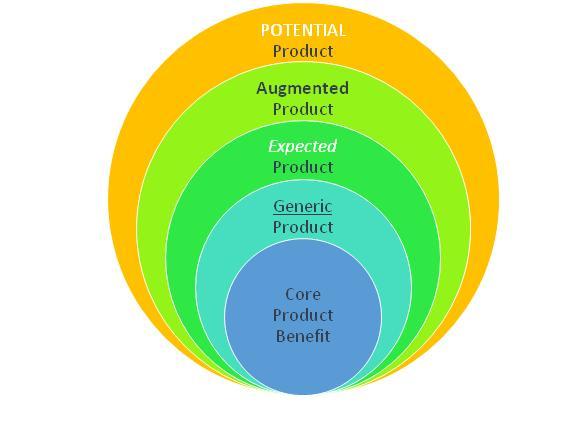How to use Philip Kotler’s 5 Product Levels in Marketing?
In a recent blog post we had discussed ‘What is a product’ in the context of the 4Ps of Marketing Mix. Marketing Guru Philip Kotler has opined that a product is not just the item itself like a toothbrush; the object which can be physically seen, held or felt or a service like a massage that is simply received.Products and the perception that consumers have about them are much more profound and complex. He suggested that a product should be profiled into multiple levels as normally perceived by consumers or customers.
In this blog, we will discuss the 5 Product Levels of Kotler and as marketers how to use them in designing and marketing the product effectively.
The 5 Product Levels of Kotler
The Five Product Levels of Kotler have been identified and refined based on psychological expectations, emotional association and perceptual aspirations of a consumer about a product. These factors create a product persona which cannot be assimilated into just the product as an object. And hence, gave rise to the 5 Product Levels.
-
Core Product Benefit
When you plan to buy or actually buy an apartment what is the thought in your mind? You are buying a place to live in which is you need to live it and call it your own. It evokes a clearly different thought then when you rent a place or sign a lease. This means you can buy any apartment as long as it is an
When you join a course say at the university; your need is to get the admission, sign up for the required course, study, appear for the exams and get certified.
The core product benefit from an apartment or a university course that you seek as a customer (buyer and (or) consumer too) is just to meet a basic need when you buy it.
-
Generic Product
The term generic has synonyms like common, basic, non-specific. A generic product is something similar. All apartments in any location, floor, size, colour etc. constitute a generic product. All courses in any university too are generic offerings to customers.
An apartment with the required entry door, non-specific number of windows (but at least 1), one or more bathrooms and one or more areas demarcated as a room form a generic apartment.
A course in any college or university or even online which has a defined syllabus, prescribed text book, set of classes, a teacher or faculty and exams followed by a certificate is a generic product.
A generic product is a stripped-down version which has the very basic features that are bare minimum to make it functional. This is the tangible offering in the hands of a customer.
-
Expected Product
The expected product is what a customer hopes to find in a product. This is where perceptual aspiration plays a role. Based on a customer’s upbringing, social background, experience, culture, country of origin; the expectation from a product varies.
A customer from a developed country will have different set of expectations from a product like an apartment compared to a customer in a developing or lower economic development country. The customer from a developed country will expect good quality construction, layout and use of material like fitments and fixtures, building certification, elevators etc. whereas a customer from a poorer country will expect an apartment building that is habitable, with electricity connection, bathrooms with water supply.
A customer seeking admission into a course will expect good teachers/ faculties, a clean and airy classroom, decent lecture sessions and course-work, duration of course to adequately absorb and assimilate the teaching material.
-
Augmented Product
An augmented product as the word suggests is an enhanced or expanded feature in a product that is a specific source of differentiation in a crowded market with multiple suppliers or vendors. A customer does not normally seek these features in a product but appreciates the add-ons and uses it as a basis of comparison with other competitors.
A common club-house or recreation room, a park, swimming pool, enclosed storage space in the apartment are example of augmented product offerings to customers. These are features that a customer may not ask for at the time of buying the apartment but feels positive and motivated on receiving them. It increases the perception of value of the apartment for the customer. They are given a sense of getting more for the price that they are paying.
In an academic course, a student getting an air conditioned classroom with projectors and screen for lectures, access to study material in the digital form, ability to listen to and view lectures in the form of webinars and downloading the study material are augmented products which eases the course experience of the students (customers) and makes their life simpler. But all courses may not provide these features or may not be suitable to integrate these features.
-
Potential Product
Consider a high-end apartment complex which gives helicopter services to their residents to the nearest airport or specific work place or a membership of an exclusive club.
Similarly, in an academic course at a university, suppose the students of marketing management are given an opportunity to participate in the team involved in a new product launch at Nike or direct internship at Amazon or Starbucks or students of IT are given an opportunity to work on a big data project at the UN.
As human beings we are easily impassive about some product or feature or improvement. The ‘WOW’ factor is easily lost or its novelty wears out. This is the crux of a product life cycle which either runs its course or is renewed through addition of newer features, functionality, or complete transformation. Potential product is what delights a customer and keeps alive their interest in it. It gives the customer something that is unexpected and probably never needed or thought of by them.
How to use the 5 Product Levels in Marketing?
Core Product
Marketers use this to decide on the fundamental offering and analyze the dynamics of the industry. If the core product is faulty, the entire marketing effort will crumble like a pack of cards. The product must satisfy some need of the customers.
For example: Building and selling an apartment is a core product idea.
Generic Product
This is the first level of differentiation as professed by Michael Porter. The features in the generic product are must – haves to get initial traction with customers. At this level, there will be lot of competition and customers looking at this level are extremely price conscious. Marketers dealing with generic product must be precise about their pricing.
Consider the example of generic drugs like paracetamol. There a re100s of competitors and hardly any differentiation. Customers do not bother from one brand to another while making the purchase decision.
Expected Product
Creating an expected product is a marketing initiative which enables the company to compete effectively at potential customer segments where the revenue projections are high. It also enables the company to target each segment with a different type of expected product (a variant of the core product) and at different price points.
Automobile companies are the most common example of expected product where ‘n’ number of variants of the same base model is available to satisfy different customer aspirations.
Augmented Product
Augmented product is an option for marketers to charge and justify higher price of a product and still acquire brand loyalty. Augmentations are made through detailed market research and gathering customer information to ascertain the features and attributes desired by different segment of customers and their willingness to pay for it. This level helps the company create strong differentiation from their competitors, serve very narrow but potentially valuable niche and gain sharp visibility in the market.
An automobile company may offer hand-stitched leather upholstery which exudes luxury within the same type of vehicle category.
Potential Product
Apple has created a potential product – the iPad which has created huge transformation and were followed by Samsung and Microsoft. No one needed a tablet like iPad and people were contented with their desktop workstations and laptops of various size and speed. The iPad opened vistas earlier unknown and untapped. Overnight it transformed both the computer and mobile phone industries.
As Marketers to succeed in this dense market of rapid innovation, creating a potential product is the source for first mover advantage in the industry, registering patents and gaining huge market share. This can happen through deep understanding of the customer profile, narrow and precise differentiation into segments, analyzing their aspirations, and source of delight and over delivering.
If you have questions about finding the 5 product levels of different products or services or need clarification, leave a comment below and we, at MakeMyAssignments, will get in touch with you.
If you have a very specific need or assignment that needs expert advice or mentoring our subject-matter assignment experts will connect with you to assist you.
In case you need help with writing an assignment or structuring it, please try our efficient assignment writing services and experience quality output and reliable insight.
MakeMyAssignments provides excellent assignment writing services and mentoring to students around the globe. We have long-standing relationship with many students over the years and some of them are part of our assignment expert network sharing their knowledge and insight to help other students attain their education objectives and career goals.
Our assignments are meant to be guidance material for students and we discourage the direct submission of the material to their college or universities.



